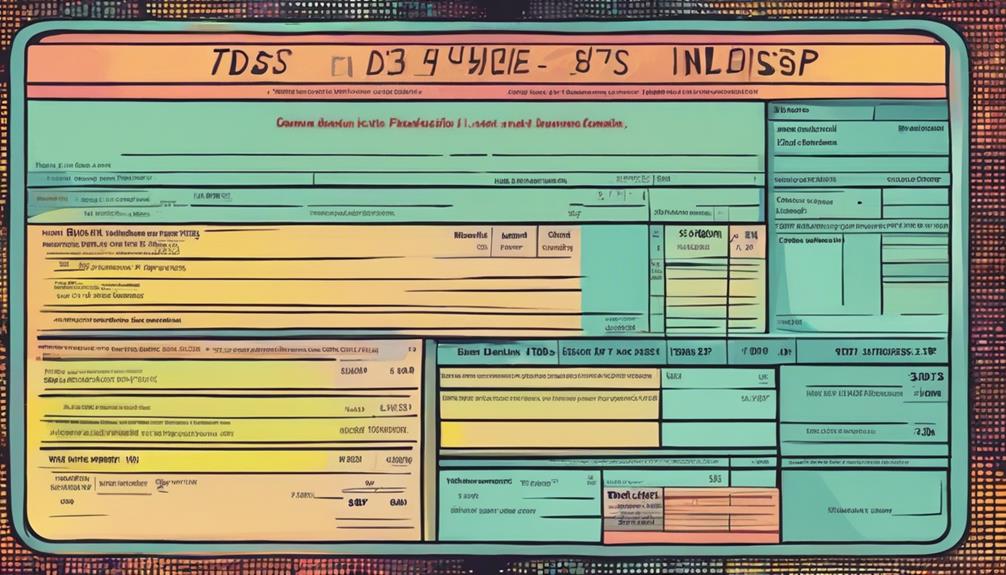Tax Deducted at Source (TDS) serves as a fundamental aspect of the tax framework, ensuring revenue collection at the point of income generation. Understanding TDS’s intricacies is paramount for individuals and organizations to navigate tax obligations effectively.
From the process of deduction to compliance requirements and potential exemptions, the domain of TDS is multifaceted. Delving deeper into the nuances of TDS reveals its significance in fostering tax discipline and streamlining the tax payment structure.
Staying abreast of TDS regulations is not only beneficial but also imperative in the domain of taxation, prompting a closer examination of its implications and applications.
Understanding the Basics of TDS

Tax Deducted at Source (TDS) is an essential tax collection mechanism in India, ensuring the upfront deduction of taxes from various income sources.
Understanding the basics of TDS involves grasping its essence, identifying the responsible parties for deduction and payment, comprehending the different payment types subject to TDS, and interpreting the TDS rate chart to ascertain the deducted tax amounts.
These fundamental aspects lay the groundwork for a detailed understanding of TDS compliance and its implications for both deductors and deductees in the tax ecosystem.
The Essence of Tax Deducted at Source (TDS)
The fundamental concept underlying Tax Deducted at Source (TDS) lies in the systematic deduction of a predetermined portion of income at the source itself.
| Key Points | Details |
|---|---|
| Tax Collection Method | Deduction at Income Source |
| Applicable Payments | Salaries, Interest, Rent, Professional Fees |
| Purpose | Guarantee Advance Tax Payment |
| Refund Process | Claimable after ITR Filing |
Who is Responsible for Deducting and Paying TDS?
Responsible parties tasked with deducting and remitting Tax Deducted at Source (TDS) include employers, individuals, entities, and financial institutions handling specific payments subject to TDS regulations.
Employers must deduct TDS on salaries, individuals/entities on specified payments like rent/professional fees/interest, banks on interest exceeding limits, and non-resident payors on certain payments.
Ensuring timely deposit of deducted TDS is important for compliance with tax laws.
Different Types of Payments Subject to TDS
- Salaries
- Rent
- Professional fees
Payments subject to Tax Deducted at Source (TDS) encompass a variety of financial transactions, including interest, dividends, lottery winnings, and property transfers.
The TDS Rate Chart: How Much Tax is Deducted?
In the domain of Tax Deducted at Source (TDS), understanding the intricacies of the TDS Rate Chart is essential for grasping how much tax is deducted from various types of payments. TDS rates vary depending on the payment type, such as salary, interest, and rent.
The Income Tax Department determines these rates, which are subject to periodic changes. Failure to apply TDS at the correct rates can lead to penalties, emphasizing the importance of adherence to regulations.
The TDS Deduction Process

The TDS deduction process is an important aspect of income tax compliance. Tax is deducted at the source before the taxpayer receives the income. This process involves understanding the scenarios triggering TDS deductions, the responsibilities of the deductor and deductee, and the various payments subject to TDS regulations.
It is essential to grasp the intricacies of when and why TDS deduction occurs, the compliance obligations of different parties, and the wide array of financial transactions covered under the TDS mechanism.
When and Why TDS Deduction Occurs
An integral component of the Indian tax system, Tax Deducted at Source (TDS) deduction is a pivotal process carried out when certain specified transactions involving income disbursements are executed.
- TDS deduction occurs for payments like salary, rent, interest, or professional fees.
- It guarantees advance tax collection by deducting a certain percentage at the source of income.
- TDS is deducted at rates set by the Income Tax Department to prevent tax evasion.
The Role of the Deductor and Deductee in TDS
From the discussion on when and why TDS deduction occurs, it is imperative to understand the intricate roles played by the deductor and deductee in the Tax Deducted at Source (TDS) process.
The deductor is responsible for deducting TDS from specified payments, while the deductee, as the recipient, receives the net amount after TDS deduction.
The deductor then files TDS returns detailing the deductions and deposits the TDS amount with the government promptly.
Key Payments Covered Under the TDS Mechanism
- Salary
- Interest
- Rent
Covering a wide range of financial transactions, Tax Deducted at Source (TDS) encompasses various key payments such as salary, interest, rent, commission, and professional fees.
TDS Compliance and Procedures

TDS compliance and procedures are important in ensuring the timely and accurate deposit of deducted taxes to the government. Understanding the due dates for depositing TDS, following step-by-step guidelines for depositing TDS, and knowing how to upload TDS statements are essential components of maintaining TDS compliance.
Additionally, being aware of the penalties associated with non-compliance, such as late payment or non-deposit of TDS, is crucial for businesses and individuals to avoid financial repercussions and stay in line with tax regulations.
The Due Date for Depositing TDS with the Government
The timely deposit of Tax Deducted at Source (TDS) with the government, due on the 7th of the subsequent month after deduction, is critical to tax compliance and adherence to regulatory requirements.
Deposit TDS promptly to avoid penalties.
Use Challan ITNS-281 on the government portal for compliance.
Late payment of TDS can attract penalties and affect tax compliance.
How to Deposit TDS: Step-by-Step Guide
Following the due date for depositing Tax Deducted at Source (TDS) with the government, the process of depositing TDS involves specific steps to guarantee compliance with tax regulations and avoid penalties.
| Step | Description |
|---|---|
| 1. | Login to the government portal. |
| 2. | Select Challan ITNS-281. |
| 3. | Fill in TDS details. |
| 4. | Verify information. |
| 5. | Make payment online. |
Uploading TDS Statements: A How-To
Initiating the process for uploading quarterly statements of Tax Deducted at Source (TDS) requires meticulous attention to detail and adherence to regulatory guidelines.
- Verify TAN details are accurate.
- Guarantee timely submission to avoid penalties.
- Utilize ClearTax software for streamlined compliance.
Penalties for Non-Compliance: Late Payment and Non-Deposit of TDS
Upon failing to adhere to TDS regulations, late payment or non-deposit of TDS can result in significant financial penalties and potential legal ramifications for the deductor.
Late payment attracts penalties of 1.5% per month on the due amount, while non-deposit leads to 1% interest charges monthly until paid.
Failure to comply may result in hefty fines and prosecution, emphasizing the importance of a timely TDS deposit to maintain good standing.
After TDS Deduction: What’s Next?

Upon the completion of TDS deduction, individuals should prioritize:
- Obtaining and comprehending their TDS certificates.
- Familiarizing themselves with TDS credits.
- Understanding Form 26AS.
Addressing any disparities in TDS details and Form 26AS promptly is essential for accurate tax reporting and compliance.
Obtaining and Understanding Your TDS Certificate
After the deduction of Tax Deducted at Source (TDS), the process of obtaining and understanding your TDS certificate is important for accurate tax compliance and credit claim purposes.
- Validate the TDS certificate received matches the details of TDS deductions.
- Confirm the accuracy of the TDS certificate against your income and payment records.
- Retain the TDS certificate safely for future reference and tax filing purposes.
TDS Credits and Form 26AS Explained
How can TDS credits and Form 26AS provide significant insights into tax liability and compliance post-TDS deduction?
TDS credits allow deductees to offset tax liability after TDS deduction.
Form 26AS offers a detailed overview of TDS deductions, including amounts deducted and credited, advance tax, and self-assessment tax.
Regularly monitoring Form 26AS guarantees accurate reporting of TDS deductions and credits during income tax return filings, aiding in compliance and minimizing errors.
Handling Mismatches in TDS Details and Form 26AS
Following the deduction of TDS, addressing discrepancies in TDS details and Form 26AS is essential for ensuring accurate tax reporting and compliance.
- Cross-verify TDS details with Form 26AS.
- Contact the deductor to rectify any mismatches.
- Timely resolution prevents delays in tax refunds and compliance issues.
Specific Scenarios of TDS

In exploring the specific scenarios of Tax Deducted at Source (TDS), it is important to understand the implications of TDS on salary payments.
The simplified process of making TDS payments online is crucial for efficient compliance with tax regulations.
Adhering to specific dates for TDS payment and compliance is essential to avoid penalties associated with TDS non-compliance.
These scenarios play a significant role in ensuring compliance with tax regulations, streamlining payment procedures, and avoiding penalties associated with TDS non-compliance.
TDS on Salary: An Overview
Tax Deducted at Source (TDS) on salary is an important mechanism for employers to deduct taxes from employees’ earnings based on their average income tax rate, considering various factors such as exemptions, deductions, and slab rates.
Employers calculate TDS based on the average income tax rate.
Consider exemptions and deductions for accurate TDS calculation.
TDS on salary is deducted monthly, impacting employees’ regular tax payments.
TDS Payment Online: Simplified Process
Moving from the domain of TDS deductions on salary, a significant aspect worth exploring is the streamlined process of making TDS payments online for various specific scenarios.
TDS payments can be conveniently made using net banking, debit cards, or credit cards. Different TDS challans cater to various payment types like salaries, interest, and rent.
Timely payment with accurate details is important to avoid interest, penalties, or legal consequences.
Important Dates for TDS Payment and Compliance
Understanding the specific deadlines for TDS deposits is paramount for ensuring adherence to regulatory requirements and avoiding potential penalties within the domain of tax compliance and payment obligations.
- The due date for the TDS deposit on rent and property purchase is 30 days from the deduction.
- TDS on salary deposit deadline: 7th of the subsequent month.
- Quarterly filing of different TDS forms based on payment nature.
Exemptions and Refunds in TDS

Understanding the exemptions and refunds is important for taxpayers when it comes to Tax Deducted at Source (TDS).
Knowing how to claim credit for TDS, determine eligibility for exemptions, and manage the process for TDS refunds.
How to Claim Credit for TDS
To optimize the benefits of Tax Deducted at Source (TDS), understanding the mechanisms for claiming credit through exemptions and refunds is essential in traversing the tax landscape effectively.
- Submit Form 15G/15H for exemptions below the taxable threshold.
- Certain payments, like bank deposit interest, have specified TDS exemptions.
- Claim excess TDS refunds by filing income tax returns with the IT department.
Exemption from TDS: Eligibility and Procedure
Eligibility for exemption from Tax Deducted at Source (TDS) is contingent upon meeting specific criteria related to income levels, age, and the nature of income. Submission of Form 15G by individuals below 60 years and Form 15H by senior citizens is important for claiming TDS exemption. Below is a table summarizing key eligibility criteria for TDS exemption:
| Eligibility Criteria | Description |
|---|---|
| Total Income | Below the taxable limit |
| Age | Below 60 for Form 15G, 60 and above for Form 15H |
| Necessary Forms | Submit Form 15G or 15H to the deductor |
The Process for Getting a TDS Refund
Individuals who have had excess tax deducted at source (TDS) can initiate the process for claiming a refund through the Income Tax Department by filing their income tax return.
- File income tax returns with accurate details.
- Await processing by the Income Tax Department.
- Refund, if approved, will be credited to the individual’s bank account.
Avoid unnecessary penalties by understanding the Interest on Late Payment of TDS with this insightful article.
Frequently Asked Questions

Clarifying frequently asked questions is important when exploring the world of Tax Deducted at Source (TDS). Understanding aspects like the applicable TDS rates in the absence of a PAN, filing procedures for a NIL TDS return, individual payment methods for TDS, and the specific provisions for TDS on payments to transporters are essential for compliance and efficient tax management.
At What Rate Will the Deductor Deduct TDS If the PAN Is Not Furnished?
In the context of Tax Deducted at Source (TDS) regulations, the deduction rate applied by the deductor in the absence of a furnished PAN is important for accurate tax compliance and transparency in financial transactions.
- If PAN is not provided, TDS is deducted at a higher rate or 20%, whichever is higher.
- This incentivizes individuals to furnish PAN details promptly.
- Non-furnishing of PAN may lead to increased tax deductions for regulatory compliance.
Can I File a NIL TDS Return as My First TDS Return?
In the context of the TDS regulations, the initial step in ensuring compliance with tax requirements includes the potential filing of a NIL TDS return.
Yes, you can file a NIL TDS return if no TDS was deducted during a particular quarter.
Filing a NIL TDS return is vital to adhere to tax regulations, even when no deductions were made, to avoid penalties.
It signifies that no tax deduction was necessary for that specific period.
How Do I Pay TDS Individually If Not Deducted?
Should you find yourself in a situation where Tax Deducted at Source (TDS) has not been deducted, the process of making individual TDS payments can be carried out using Challan 280 on the government’s portal.
- Select the correct assessment year and payment type.
- Verify payment details before submission.
- Keep the Challan counterfoil as proof of payment.
What is the provision of TDS for payment to transporters?
With regards to payments made to transporters, understanding the provisions of Tax Deducted at Source (TDS) is important for compliance with the Indian tax regulations.
TDS on transporter payments applies to individuals or HUFs at 1% with PAN and 5% without PAN.
Exemptions exist if payments to a single transporter stay below Rs. 75,000 annually.
Failure to deduct TDS on transporter payments can result in penalties and interest charges.
Final Thoughts on Tax Deducted at Source (TDS)

Understanding Tax Deducted at Source (TDS) is pivotal for both taxpayers and businesses to guarantee compliance with tax regulations.
Simplifying the TDS process can alleviate the burden on taxpayers and streamline tax collection mechanisms.
Simplifying TDS for Taxpayers and Businesses
Implementing effective strategies to streamline Tax Deducted at Source (TDS) procedures can greatly benefit both taxpayers and businesses.
- Utilize automation tools for accurate TDS calculations and filings.
- Conduct regular TDS audits to guarantee compliance with regulations.
- Provide training to employees and stakeholders on TDS processes and updates.














FIND US ON SOCIALS